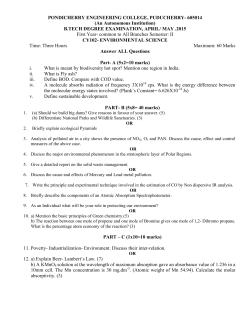
Chemistry 10123 and 10125, Exam 3 Answer Key March 23, 2015
Answer Key
Chemistry 10123 and 10125, Exam 3
March 23, 2015
In all of the "SHOW ALL WORK" questions, include balanced, net-ionic equations for all
relevant chemical reactions and clearly indicate which ones are considered as equilibrium
reactions. Clearly state and justify any assumptions you make. Some selected equilibrium
constants that are required in certain problems are listed on the last page of this exam.
1. (12 points) SHOW ALL WORK. An Olympic swimming pool is 50 m long, 25 m wide, and 2.0 m
deep. Gold(III) hydroxide, Au(OH)3, is extremely insoluble in water. Determine the number of
Au3+ ions that would be present in solution if the water in an Olympic pool was saturated with
Au(OH)3. (Note: 1.0 m3 = 103 L)
Au(OH)3(s)
Au3+(aq) + 3 OH (aq)
Let x = molar solubility
Since Ksp is extremely small, the concentration of OH- can't be ignored.
[Au3+] = x
[OH-] = 10-7 + 3x
Ksp = [Au3+] [OH-]3
5.5 x 10-46 = (x) (10-7 + 3x)3
5.5 x 10-46 ≈ (x) (10-7)3
assume 3x << 10-7
x ≈ 5.5 x 10-25 M
(assumption is OK!)
V = (50 m) (25 m) (2.0 m) (103 L / m3) = 2.50 x 106 L
(2.50 x 106 L) (5.5 x 10-25 mole/L) (6.022 x 1023 atoms / mole)
= 8.3 x 105 Au atoms
2. (8 points) SHOW ALL WORK. Determine the value of the equilibrium constant (Kc) for the
following reaction.
Mg(OH)2(s) + 2 NH4+(aq)
Mg2+(aq) + 2 NH3(aq) + 2 H2O
Mg(OH)2(s)
Mg2+(aq) + 2 OH-(aq)
Ksp
2 { NH4+(aq) + OH-(aq)
NH3(aq) + H2O }
(1/Kb)2
Kc = Ksp (1 / Kb)2 = Ksp / (Kb)2
Kc = (2.1 x 10-13) / (1.76 x 10-5)2 = 6.8 x 10-4
3. SHOW ALL WORK. Using the lab set-up pictured below, 30.00 mL of 0.200 M HCl is titrated
with a 0.200 M solution of sodium nitrite (NaNO2). Determine the pH of the solution at each of the
following points in the titration. (Think carefully about the chemistry involved here!)
(a) (8 points) after addition of 20.00 mL of 0.200 M NaNO2
moles HCl initial = (0.030 L) (0.200 mole/L) = 0.00600 mole
moles NO2 added = (0.020 L) (0.200 mole/L) = 0.00400 mole
neutralization: NO2 + H+ → HNO2 (weak acid)
excess HCl = 0.00600 - 0.00400 = 0.00200 mole HCl
(strong acid)
[H+] = (0.00200 mole) / (0.0500 L) = 0.0400 M
pH = - log(0.0400) = 1.40
(b) (10 points) at the equivalence point
all HCl has been neutralized (converted to HNO2)
equilibrium:
H+ + NO2-
HNO2
Ka = [H+] [NO-] / [HNO2]
Let x = [H+]
volume at Eq Pt = 30.00 mL HCl + 30.00 mL NaNO2 = 60.00 mL
molarity of HNO2 = (0.0060 mole) / (0.060 L) = 0.100 M
Ka = 4.6 x 10-4 = x2 / (0.10 - x)
(assume x << 0.10)
4.6 x 10-4 ≈ x2 / (0.10)
x = [H+] ≈ 6.78 x 10-3
(assumption is OK)
pH = 2.17
(c) (10 points) after addition of 50.00 mL of 0.200 M NaNO2
Now there is excess NaNO2 mixed with HNO2, therefore a buffer solution!
total NO2- = (0.050 L) (0.200 mole/L) = 0.0100 moles
excess NO2- = 0.0100 mole - 0.00600 mole = 0.00400 mole
equilibrium: HNO2
H+ + NO2[H+] = Ka (moles HNO2 / moles NO2-)
= (4.6 x 10-4) (0.00600 mole / 0.00400 mole) = 6.90 x 10-4
∴ pH = 3.16
4. (9 points) A certain diprotic acid, H2A, has pKa1 = 4.75 and pKa2 = 9.15. For a 1.00 M solution of
H2A, what are the following values? (Work need not be shown!)
(a) pH = 2.38
(b) [HA ] = 4.22 x 10-3 M
(c) [OH ] = 2.37 x 10-12 M
(d) [A2-] = 7.08 x 10-10 M
5. (12 points) Indicate whether an aqueous solution of each of the following substances is acidic (A),
basic (B), or neutral (N). Also, for each solution, write the balanced chemical equation for the
major equilibrium that is occurring.
(a) Basic Mg(HCO2)2
HCO2 + H2O
HCO2H + OH
(b) Acidic (CH3)2NH2Br
(CH3)2NH2+ + H2O
(CH3)2NH + H3O+
(c) Acidic Cr(NO3)3
Cr(H2O)63+ + H2O
Cr(H2O)5(OH)2+ + H3O+
(d) Basic HONH2
HONH2
HONH3+ + OH-
+ H2O
6. (12 points) SHOW ALL WORK. Determine the molar solubility of cadmium phosphate,
Cd3(PO4)2, in a 1.80 M solution of KI.
3 Cd2+(aq) + 2 PO43-(aq)
Ksp
Cd3(PO4)2(s)
(Kf)3
3 { Cd2+(aq) + 4 I-(aq)
CdI42-(aq) }
Cd3(PO4)2(s) + 12 I-(aq)
3 CdI42-(aq) + 2 PO43-(aq)
Knet = (2.5 x 10-33) (2.0 x 106)3 = 2.0 x 10-14
(still a small K!)
Knet = [CdI42-]3 [PO43-]2 / [I-]12
Knet
Let x = molar solubility of Cd3(PO4)2
2.0 x 10-14 = (3x)3 (2x)2 / (1.80 - 12x)12
2.0 x 10-14 ≈ 108 x5 / (1.80)12
x = 2.9 x 10-3 M
(assumption is OK)
(assume 12x << 1.80)
7. Imagine that you show up for a lab practical in Gen Chem and you are given four labeled bottles that
contain 250 mL each of the following solutions.
A: 0.300 M HBr
B: 0.300 M Ba(OH)2
C: 0.300 M NH4Br
D: 0.300 M HOCN
(a) (9 points) The main task of the lab practical is to prepare a buffer solution with a pH of 10.00.
Think about which two solutions you would mix together to accomplish this. (Fill in the blanks
with the correct letters.) I would mix the entire 250 mL of solution C with a smaller volume of
solution B. Briefly explain your answers by giving specific reasons for selecting each of the two
solutions. Include a balanced chemical equation for any reaction that occurs upon mixing your
chosen solutions.
The reaction of OH with NH4+ will produce some NH3, thus yielding an NH4+ / NH3
buffer solution! This buffer will have a pH comparable to pKa for the weak acid NH4+
which is Kw / Kb.
For NH3, pKb = - log Kb = - log(1.76 x 10-5) = 4.75
pH ≈ pKa = pKw - pKb = 14.00 - 4.75 = 9.25 (i.e., pH ≈ 10)
(b) (10 points) SHOW ALL WORK. Determine the volume (in mL) of the solution you selected in
part (a) that must be added to 250 mL of the other solution to make the buffer with pH = 10.00.
NH4+
NH3 + H+
Ka = 10-14 / (1.76 x 10-5) = 5.68 x 10-10
mole NH4+ initial = (0.250 L) (0.300 mole/L) = 0.0750 moles
buffer solution:
Ka equilibrium:
Let x = mole OH- required
after reaction: moles NH4+ = 0.0750 - x and moles NH3 = x
[H+] = Ka (moles MH4+) / (moles NH3)
10-10 = (5.68 x 10-10) (0.0750 - x) / x
x = 0.0638 mole OH(0.0638 mole OH-) (1 mole Ba(OH)2 / 2 mole OH-) (103 mL / 0.300 mole)
= 106 mL
Remove this page and use for scratch paper!
Substance
Equilibrium Constant(s)
HC2H3O2 ..................Ka = 1.75 x 10-5
HCHO2 ......................Ka = 1.8 x 10-4
HNO2 .........................Ka = 4.6 x 10-4
HCN ...........................Ka = 6.2 x 10-10
HOCN ........................Ka = 3.3 x 10-4
H2CO3 .......................Ka1 = 4.3 x 10-7
Ka2 = 5.6 x 10-11
H2S ............................Ka1 = 8.9 x 10-8
Ka2 = 1.0 x 10-19
NH3 ............................Kb = 1.76 x 10-5
CH3NH2 ....................Kb = 4.4 x 10-4
(CH3)2NH..................Kb = 5.4 x 10-4
HONH2 ......................Kb = 9.1 x 10-9
Mg(OH)2....................Ksp = 2.1 x 10-13
Cu(OH)2 ....................Ksp = 2.2 x 10-20
Cr(OH)3 .....................Ksp = 6.3 x 10-31
Au(OH)3 ....................Ksp = 5.5 x 10-46
CuS.............................Ksp = 1.3 x 10-36
CdCO3 .......................Ksp = 1.0 x 10-12
Cd3(PO4)2 .................Ksp = 2.5 x 10-33
Cd(CN)42- .................Kf = 3.0 x 1018
CdI42- ........................Kf = 2.0 x 106
Cu(NH3)42+ ..............Kf = 1.7 x 1013
Cu(CN)42- .................Kf = 1.0 x 1029
© Copyright 2025








